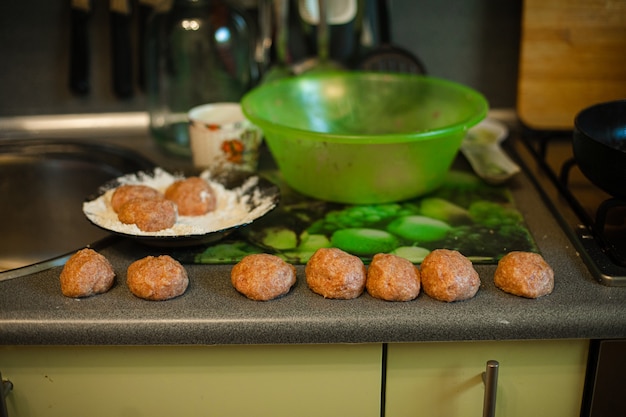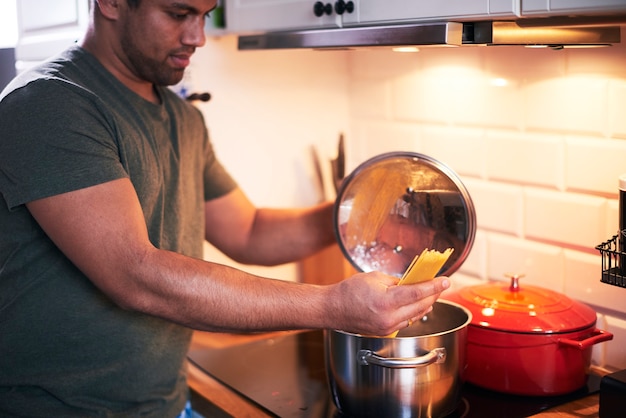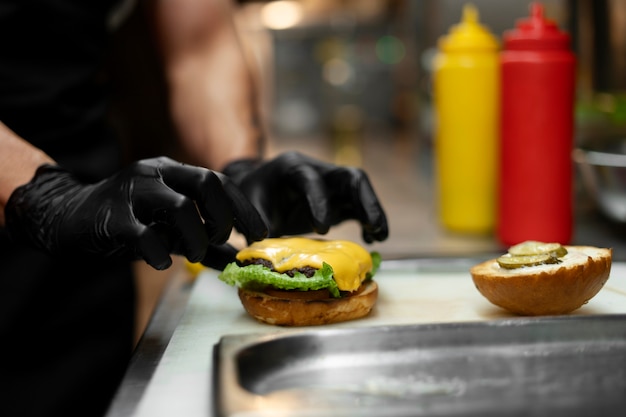There's nothing quite like a juicy, perfectly cooked burger. But sometimes, achieving that perfect result on the stovetop can feel like a culinary gamble. You might end up with a dry, overcooked puck or a raw, undercooked mess. Fear not! With a few tips and tricks, you can conquer the art of stovetop burger cooking and become a burger-making champion.
Over the years, I've learned a thing or two about making burgers on the stovetop. I've had my share of disasters, but I've also had some triumphs, and I'm here to share the wisdom I've gained along the way. From choosing the right meat to mastering the perfect sear, I'll guide you through every step, making your next batch of burgers a success.
(Part 1) The Patty: Building the Foundation for a Great Burger

The journey to a perfect burger starts with the patty. Choosing the right meat and forming the patty with care sets the stage for a delicious result.
Choosing the Right Meat
ground beef is my go-to choice for burgers, and I always aim for a blend that's about 80% lean and 20% fat. This balance ensures a juicy and flavorful burger without being overly greasy. But hey, the world of ground beef is your oyster! If you prefer a leaner burger, go for a higher percentage of lean meat. Or, if you're feeling adventurous, you can even try different types of ground meat, like lamb, turkey, or chicken. Just remember that each meat has its own cooking time and needs to be adjusted accordingly.
Making Your Own Patties
There's something incredibly satisfying about making your own burger patties. You have complete control over the ingredients, and you can customize them to your liking.
My Favourite Homemade Patty Recipe:
- Ingredients:
- 1 pound ground beef (80% lean/20% fat)
- 1 teaspoon salt
- 1/2 teaspoon black pepper
- 1/4 teaspoon onion powder (optional)
- 1/4 teaspoon garlic powder (optional)
- Instructions:
- In a large bowl, gently combine all the ingredients. Don't overmix, as this can make the patties tough.
- Divide the mixture into 4 equal portions.
- Shape each portion into a patty, about 1/2 inch thick.
- Create a small indentation in the center of each patty. This helps prevent the burgers from puffing up too much while cooking.
- Refrigerate the patties for at least 30 minutes before cooking. This helps them maintain their shape and prevents them from falling apart during cooking.
Feel free to get creative with your patties! Add chopped onions, mushrooms, or even cheese for a gourmet twist. Just remember to gently incorporate these additions to avoid overworking the meat.
(Part 2) Essential Tools for Stovetop Burger Success

Having the right tools is crucial for cooking perfect burgers on the stovetop. These tools will help you achieve that perfect sear, cook your burgers evenly, and ensure they're cooked to your liking.
1. A Heavy-Bottomed Skillet or Pan
A heavy-bottomed skillet or pan is essential for even heat distribution, ensuring your burgers cook evenly on both sides. You don't want a flimsy pan that warps under the heat and ruins your masterpiece! Cast iron is a classic choice for its excellent heat retention, but stainless steel works just as well.
2. A meat thermometer: Your Accuracy Guardian
Don't underestimate the importance of a meat thermometer. It's your secret weapon for ensuring your burgers are cooked to perfection. While you can rely on your eyes to judge doneness, a thermometer gives you the most accurate and reliable results, taking the guesswork out of cooking.
3. A Sturdy Spatula
You need a spatula that can lift and flip those burgers with ease without breaking them apart. Look for a sturdy spatula with a wide blade for optimal control.
4. A Burger Press (Optional, but Recommended)
A burger press is a great tool for shaping consistent and perfectly sized patties. It helps ensure even thickness and creates a beautiful, uniform appearance. Plus, it makes the burger-making process a breeze.
(Part 3) Prepping for Perfection: Setting the Stage for a Delicious Outcome

With your ingredients and tools ready, it's time to prep for cooking. These simple steps will help you achieve that perfectly cooked burger you've been dreaming of.
1. Getting the Heat Right
The key to perfect stovetop burgers is medium-high heat. You want the pan to be hot enough to sear the burgers nicely and create a beautiful crust, but not so hot that they burn. Aim for about 350-375°F (175-190°C) for optimal results.
2. Preheating Your Pan: The Essential First Step
Before you even think about adding the patties, make sure your pan is nice and hot. Add a little oil to the pan – olive oil or vegetable oil are good choices – and heat it up over medium-high heat for about 2-3 minutes. You'll know it's ready when the oil starts to shimmer and a drop of water sizzles immediately when you add it to the pan.
3. Seasoning Your Burgers: Enhancing the Flavour
While your pan is preheating, season your patties. I keep it simple with salt and pepper, but you can get creative with other spices like garlic powder, onion powder, or paprika. Season generously, but avoid overpowering the natural flavour of the beef.
(Part 4) Cooking the Perfect Burger: A Step-by-Step Guide
You've prepped your ingredients, got your tools ready, and the pan is sizzling hot. Now, it's time to cook! Let's dive into the steps that will transform those patties into mouthwatering burgers.
1. The Art of Searing: Creating that Delicious Crust
Place your seasoned patties in the hot pan, making sure there's enough space between them. Overcrowding the pan will hinder even cooking. Let them cook undisturbed for 3-4 minutes per side. This is the critical step for creating that beautiful, crispy crust that's the hallmark of a great burger. Don't be tempted to flip them too early. You'll know they're ready when they've developed a nice brown crust and are easily released from the pan.
2. Flipping and Cooking Through: Reaching That Perfect Doneness
Once the first side is seared, gently flip the burgers with a spatula. Continue cooking for 3-4 minutes on the other side. For extra flavour and moisture, add a pat of butter to the pan. Now, it's time to bring out your trusty meat thermometer.
Target internal temperatures:
- Medium-rare: 130°F (54°C)
- Medium: 140°F (60°C)
- Well-done: 160°F (71°C)
Insert the thermometer into the thickest part of the burger to ensure it's cooked to your liking.
3. Resting and Serving: A Final Touch for a Juicy Outcome
Once the burgers are cooked to your desired level of doneness, remove them from the pan and let them rest for 5-10 minutes before serving. This allows the juices to redistribute, resulting in a more juicy and flavorful burger.
Now, it's time to unleash your creativity! Serve those perfect burgers on toasted buns with your favourite toppings – cheese, lettuce, tomato, onion, pickles, ketchup, mustard – the possibilities are endless!
(Part 5) Avoiding Common Mistakes: Tips and Tricks for Burger Perfection
We've all encountered those burger blunders – the patties sticking to the pan, turning out dry and tough, or lacking that beautiful sear. But fear not! I've got a few tricks up my sleeve to help you avoid these common pitfalls.
1. Preventing Sticking: Ensuring a Smooth Cooking Experience
To avoid sticking, make sure your pan is nice and hot before adding the patties. Lightly grease the pan with oil or butter for extra insurance. And, as always, don't overcrowd the pan – give those burgers space to breathe and cook evenly.
2. Avoiding Overcooking: Achieving Juicy, flavorful burgers
Overcooking is a common burger mistake that can lead to dry, tough patties. Remember, the goal is to achieve a juicy, flavorful burger. Use your meat thermometer to ensure they're cooked to your liking. Don't be afraid to take them off the heat a little earlier than you think they need. You can always cook them a little longer if you prefer them well-done.
3. Achieving a Beautiful Sear: Mastering that Crispy Crust
For that perfect sear, ensure your pan is hot enough. The heat will create a nice crust and lock in the juices. Let those burgers cook undisturbed on each side for at least 3-4 minutes before flipping. Avoid constantly moving them around, as this will prevent a proper sear from forming.
(Part 6) Beyond the Basics: Exploring Different cooking techniques
The traditional stovetop method is great, but there are other techniques you can try to enhance your burger-making skills.
1. reverse searing: A Method for Evenly Cooked Burgers
This technique involves cooking the burgers slowly over low heat until they reach your desired internal temperature, and then searing them over high heat for a few minutes to create a nice crust. It's a great way to ensure juicy and evenly cooked burgers.
2. The Power of Cast Iron: Enhancing Heat Distribution
As I mentioned earlier, cast iron is a great choice for cooking burgers. It distributes heat evenly and retains heat well, which is ideal for achieving that perfect sear. Just make sure to preheat the skillet thoroughly before adding the patties.
3. Experimenting with Flavors: Adding a Personal Touch
Get creative with your burgers! Add different spices and herbs to the meat mixture, or experiment with cheese, bacon, or other toppings. There's no limit to what you can create!
(Part 7) Mastering Stovetop burger variations: Expanding Your Burger Horizons
You've mastered the basics, but now it's time to explore some delicious variations that will take your burger game to the next level.
1. Smash Burgers: Thin, Crispy, and Full of Flavor
Smash burgers are all about thin, crispy patties with a juicy interior. To make a smash burger, flatten the patty with a spatula in a hot pan. Aim for a thickness of about 1/4 inch. The key is to create a large surface area to get that perfect, crispy sear.
2. Stuffed Burgers: A Gourmet Delight
For a gourmet twist, try stuffed burgers. You can stuff the burgers with cheese, bacon, mushrooms, or anything else that tickles your fancy. Just make sure to wrap the filling securely within the patty so it doesn't fall out during cooking.
3. Veggie Burgers: Delicious Plant-Based Options
Don't forget about veggie burgers! There are many delicious options available at the supermarket or you can make your own. Follow the same cooking instructions as you would for a beef burger.
(Part 8) FAQs - Frequently Asked Questions
1. How do I tell if a burger is cooked through?
The best way to tell if a burger is cooked through is to use a meat thermometer. Insert the thermometer into the thickest part of the burger.
Target Internal Temperatures:
- Medium-rare: 130°F (54°C)
- Medium: 140°F (60°C)
- Well-done: 160°F (71°C)
You can also check for doneness by pressing the center of the burger. If it feels firm and springy, it's cooked through. If it feels soft and mushy, it's not quite done yet.
2. What if my burger is too dry?
If your burger is too dry, there are a few things you can do. First, try adding a little moisture to the patty. You can do this by adding a tablespoon of water to the pan while the burger is cooking. You can also add a pat of butter to the pan for extra flavour and moisture. Another tip is to avoid overcooking the burger. Cook it to your desired level of doneness and then remove it from the heat. Allowing the burger to rest for a few minutes will also help to redistribute the juices and make it more juicy.
3. Can I add cheese to my burger while it’s cooking?
Yes, you can add cheese to your burger while it's cooking. Just place a slice of cheese on top of the burger during the last minute or two of cooking. The heat from the pan will melt the cheese and create a gooey, delicious topping. You can also try adding cheese to the burger after it's cooked. This is a good option if you want to avoid melting the cheese too much.
4. What are some good toppings for burgers?
The beauty of burgers is that they're incredibly versatile. You can top them with anything you like! Some classic toppings include cheese, lettuce, tomato, onion, pickles, ketchup, and mustard. But feel free to get creative and experiment with other toppings, like bacon, avocado, mushrooms, or even caramelized onions.
5. How do I keep my burgers warm while I cook the rest?
After you’ve cooked your burgers, keep them warm by transferring them to a baking sheet lined with foil. Place the sheet in a 200°F (93°C) oven until you’re ready to serve. This will keep your burgers warm and prevent them from getting cold while you finish cooking the rest of your meal.
Remember, practice makes perfect! Don't be afraid to experiment and find what works best for you. With a little effort, you'll become a stovetop burger master in no time. Happy grilling!
Everyone is watching

How to Cook Frozen Lobster Tails Perfectly: A Step-by-Step Guide
RecipesLobster. Just the word conjures up images of lavish meals, special occasions, and a taste of luxury. But let's...

Pigs in a Blanket Cooking Time: How Long to Bake for Perfect Results
RecipesAh, pigs in a blanket. Just the name conjures up images of those delightful little parcels of crispy pastry en...

Pork Fillet Cooking Time: How Long to Cook It Perfectly
RecipesPork fillet, or tenderloin as it's sometimes called, is a real favourite in our house. It's so versatile, and...

The Ultimate Guide to Cooking Delicious Frankfurters
RecipesLet's face it, we all love a good frankfurter. It's a classic, simple, and always satisfying. But let's be rea...

The Ultimate Guide to Tender, Juicy Pulled Pork
RecipesRight, let's talk pulled pork. It's one of those dishes that just screams "comfort food," doesn't it? I mean...
